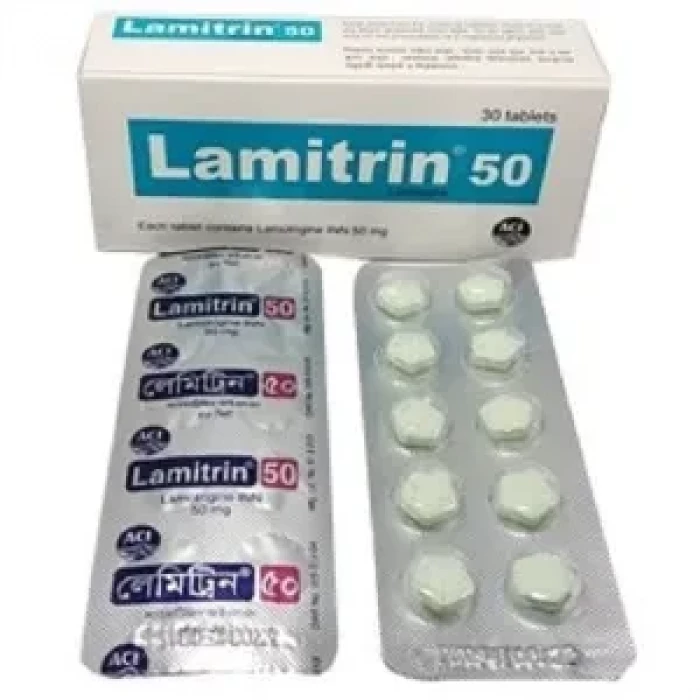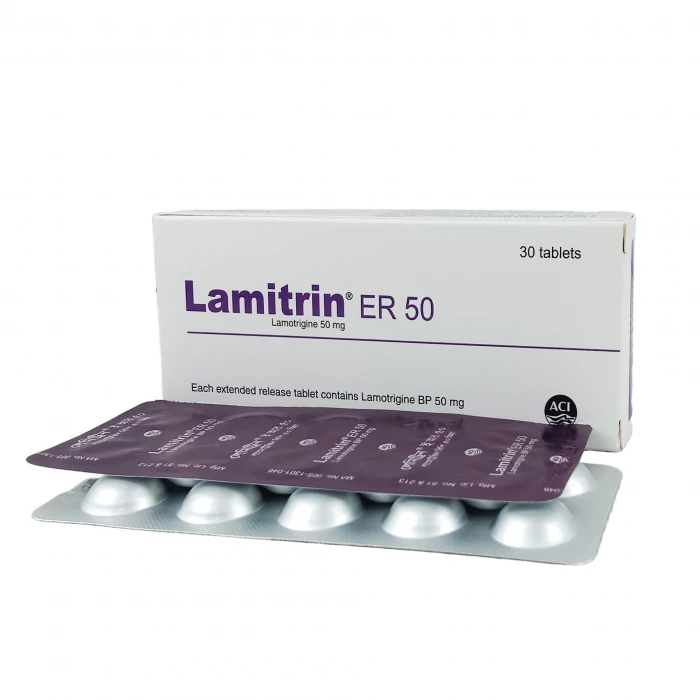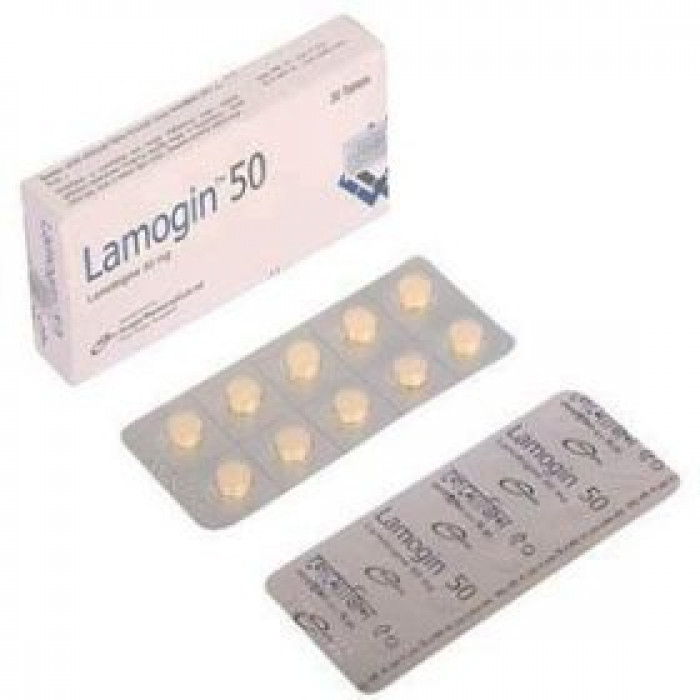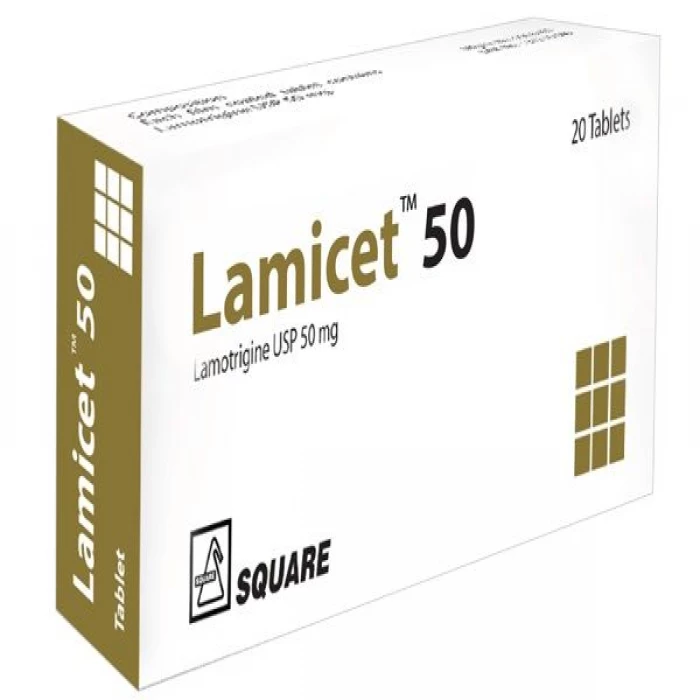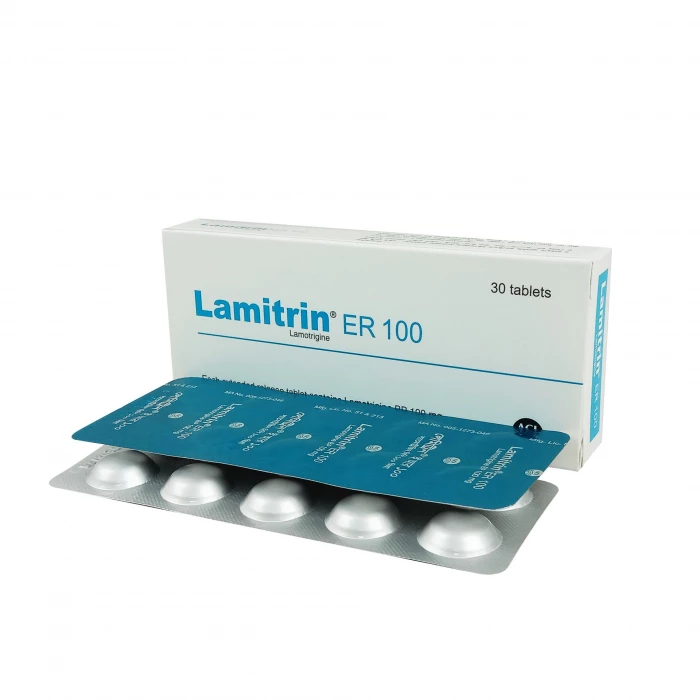
✔ 100% Authentic Product
👁️ Currently Viewing 1671
Lamitrin ER 100mg Tablet 10pcs
Lamitrin ER Indications
Epilepsy (Adjunctive Therapy) - Patients aged 2 years and older:
- Partial-onset seizures
- Primary generalized tonic-clonic seizures
- Generalized seizures of Lennox-Gastaut syndrome
- Epilepsy (Monotherapy) - Patients aged 16 years and older
- Bipolar Disorder - Patients aged 18 years and older
Discount
Price: ৳ 282
MRP:
৳
300
6%
Off

100% Genuine Products, Guaranteed

Safe & Secure Payments, Always

Fast, Secure & Efficient Delivery

Proper Packaging
 Cash on Delivery - All over Bangladesh
Cash on Delivery - All over Bangladesh Regular Delivery - 12-24 Hours, Dhaka City* Charge Tk.39-59
Regular Delivery - 12-24 Hours, Dhaka City* Charge Tk.39-59 Regular Delivery - 24-48 Hours, Other Cities* Charge Tk.99-110
Regular Delivery - 24-48 Hours, Other Cities* Charge Tk.99-110
 ফ্রি ডেলিভারিঃ - ৯৯৯ টাকা+ অর্ডারে, ঢাকা
শহরে
ফ্রি ডেলিভারিঃ - ৯৯৯ টাকা+ অর্ডারে, ঢাকা
শহরে ফ্রি ডেলিভারিঃ - ২৯৯৯ টাকা+ অর্ডারে, ঢাকার
বাহিরে
ফ্রি ডেলিভারিঃ - ২৯৯৯ টাকা+ অর্ডারে, ঢাকার
বাহিরে
100% Genuine Products, Guaranteed
Safe & Secure Payments, Always
Fast, Secure & Efficient Delivery
Proper Packaging
 Cash on Delivery - All over Bangladesh
Cash on Delivery - All over Bangladesh Regular Delivery - 12-24 Hours, Dhaka City* Charge Tk.39-59
Regular Delivery - 12-24 Hours, Dhaka City* Charge Tk.39-59 Regular Delivery - 24-48 Hours, Other Cities* Charge Tk.99-110
Regular Delivery - 24-48 Hours, Other Cities* Charge Tk.99-110 ফ্রি ডেলিভারিঃ - ৯৯৯ টাকা+ অর্ডারে, ঢাকা
শহরে
ফ্রি ডেলিভারিঃ - ৯৯৯ টাকা+ অর্ডারে, ঢাকা
শহরে ফ্রি ডেলিভারিঃ - ২৯৯৯ টাকা+ অর্ডারে, ঢাকার
বাহিরে
ফ্রি ডেলিভারিঃ - ২৯৯৯ টাকা+ অর্ডারে, ঢাকার
বাহিরে
✅ Description:
Epilepsy:
- Condition: Epilepsy is a neurological disorder characterized by repeated seizures. These seizures are episodes of disturbed brain activity that can cause a variety of symptoms, including uncontrolled jerking movements and loss of consciousness.
- Treatment: Lamotrigine is an anticonvulsant medication used to manage epilepsy. It works by stabilizing electrical activity in the brain, reducing the frequency and severity of seizures.
Bipolar Disorder:
- Condition: Bipolar disorder is a mental health condition marked by extreme mood swings. These swings include emotional highs (mania or hypomania) and lows (depression). Symptoms can range from hyperactivity, elevated mood, and increased energy during manic episodes to fatigue, sadness, and hopelessness during depressive episodes.
- Treatment: Lamotrigine is used as a mood stabilizer in the treatment of bipolar disorder. It helps in reducing mood swings, particularly by preventing or lessening the severity of depressive episodes, making it a valuable medication for maintaining long-term mood stability in individuals with bipolar disorder
Safety Advices

Alcohol
UNSAFE
Lamitrin ER 100mg Tablet may cause excessive drowsiness when taken with alcohol.

Pregnancy
CONSULT YOUR DOCTOR
Lamitrin ER 100mg Tablet may be unsafe during pregnancy. Animal studies have shown harmful effects on the developing baby. Your doctor will consider the benefits and potential risks before prescribing it.

Breastfeeding
CONSULT YOUR DOCTOR
Lamitrin ER 100mg Tablet is probably safe during breastfeeding. Limited human data suggest it does not pose a significant risk to the baby. Monitor the baby for rash, sleepiness, or poor sucking, and get periodic platelet count and liver function tests.

Driving
CAUTION
Lamitrin ER 100mg Tablet may cause dizziness and double vision, affecting your ability to drive.

Kidney
CONSULT YOUR DOCTOR
Lamitrin ER 100mg Tablet should be used with caution in patients with kidney disease. Dose adjustment may be necessary. Consult your doctor.

Liver
CONSULT YOUR DOCTOR
Lamitrin ER 100mg Tablet should be used with caution in patients with liver disease. Dose adjustment may be necessary. Consult your doctor.
✔️ Uses of Lamitrin ER 100mg Tablet
Epilepsy (fits), and Bipolar disorder.
✔️ Over Dose of Lamitrin ER 100mg Tablet
Seek emergency medical treatment or contact the doctor in case of an overdose.
✔️ Missed Dose of Lamitrin ER 100mg Tablet
If you miss a dose of Lamotrigine, take the missed dose as soon as you remember. If it’s almost time for your next dose, skip the missed dose. Do not double your dose to make up for the missed dose.
✔️ Quick Suggestions:
- Take Lamotrigine with or without food.
- Do not take in larger amounts than advised.
- Consult the doctor if you experience any undesirable effects.
- Do not stop taking the medicine without consulting your doctor as it may cause seizures.
✔️ Indication of Lamitrin ER 100mg Tablet
Lamotrigine is an anticonvulsant that is used to control seizures and is also used in bipolar disorders. Take this medicine at the same time regularly. Do not stop taking this medicine suddenly without informing your doctor as it may cause withdrawal symptoms like seizures.
✔️ Pharmacology
The exact mechanism of action of lamotrigine is not fully elucidated, as it may exert cellular activities that contribute to its efficacy in a range of conditions. Although chemically unrelated, lamotrigine actions resemble those of phenytoin and carbamazepine, inhibiting voltage-sensitive sodium channels, and stabilizing neuronal membranes, thereby modulating the release of presynaptic excitatory neurotransmitters.
Lamotrigine likely acts by inhibiting sodium currents by selectively binding to the inactive sodium channel, suppressing the release of the excitatory amino acid, glutamate. The mechanism of action of lamotrigine in reducing anticonvulsant activity is likely the same in managing bipolar disorder. Studies on lamotrigine have identified its binding to sodium channels in a fashion similar to local anesthetics, which could explain the demonstrated clinical benefit of lamotrigine in some neuropathic pain states.
Lamotrigine displays binding properties to several different receptors. In laboratory binding assays, it demonstrates a weak inhibitory effect on the serotonin 5-HT3 receptor. Lamotrigine also weakly binds to Adenosine A1/A2 receptors, α1/α2/β adrenergic receptors, dopamine D1/D2 receptors, GABA A/B receptors, histamine H1 receptors, κ-opioid receptor (KOR), mACh receptors and serotonin 5-HT2 receptors with an IC50>100 µM. Weak inhibitory effects were observed at sigma opioid receptors. An in vivo study revealed evidence that lamotrigine inhibits Cav2.3 (R-type) calcium currents, which may also contribute to its anticonvulsant effects.
✔️ Dosage Regimen for Lamotrigine in Epilepsy and Bipolar Disorder
Epilepsy - Adults and Children Older than 12 Years
Weeks 1 & 2:
- No Carbamazepine, Phenytoin, Phenobarbital, Primidone, or Valproate: 25 mg daily
- With Valproate: 25 mg every other day
- With Carbamazepine, Phenytoin, Phenobarbital, or Primidone (No Valproate): 50 mg daily
Weeks 3 & 4:
- No Carbamazepine, Phenytoin, Phenobarbital, Primidone, or Valproate: 50 mg daily
- With Valproate: 25 mg daily
- With Carbamazepine, Phenytoin, Phenobarbital, or Primidone (No Valproate): 100 mg daily (in 2 divided doses)
Week 5 Onward to Maintenance:
- No Carbamazepine, Phenytoin, Phenobarbital, Primidone, or Valproate: Increase by 50 mg/day every 1-2 weeks to 225-375 mg/day (in 2 divided doses)
- With Valproate: Increase by 25-50 mg/day every 1-2 weeks to 100-200 mg/day with Valproate alone, or 100-400 mg/day with Valproate and enzyme-inducing drugs (in 1-2 divided doses)
- With Carbamazepine, Phenytoin, Phenobarbital, or Primidone (No Valproate): Increase by 100 mg/day every 1-2 weeks to 300-500 mg/day (in 2 divided doses)
Epilepsy - Children Aged 2 to 12 Years
Weeks 1 & 2:
- No Carbamazepine, Phenytoin, Phenobarbital, Primidone, or Valproate: 0.3 mg/kg/day (in 1-2 divided doses)
- With Valproate: 0.15 mg/kg/day (in 1-2 divided doses)
- With Carbamazepine, Phenytoin, Phenobarbital, or Primidone (No Valproate): 0.6 mg/kg/day (in 2 divided doses)
Weeks 3 & 4:
- No Carbamazepine, Phenytoin, Phenobarbital, Primidone, or Valproate: 0.6 mg/kg/day (in 2 divided doses)
- With Valproate: 0.3 mg/kg/day (in 1-2 divided doses)
- With Carbamazepine, Phenytoin, Phenobarbital, or Primidone (No Valproate): 1.2 mg/kg/day (in 2 divided doses)
Week 5 Onward to Maintenance:
- No Carbamazepine, Phenytoin, Phenobarbital, Primidone, or Valproate: Increase by 0.6 mg/kg/day every 1-2 weeks to 4.5-7.5 mg/kg/day (max 300 mg/day in 2 divided doses)
- With Valproate: Increase by 0.3 mg/kg/day every 1-2 weeks to 1-3 mg/kg/day with Valproate alone, or 1-5 mg/kg/day (max 200 mg/day in 1-2 divided doses)
- With Carbamazepine, Phenytoin, Phenobarbital, or Primidone (No Valproate): Increase by 1.2 mg/kg/day every 1-2 weeks to 5-15 mg/kg/day (max 400 mg/day in 2 divided doses)
Bipolar Disorder - Adults
Weeks 1 & 2:
- No Carbamazepine, Phenytoin, Phenobarbital, Primidone, or Valproate: 25 mg daily
- With Valproate: 25 mg every other day
- With Carbamazepine, Phenytoin, Phenobarbital, or Primidone (No Valproate): 50 mg daily
Weeks 3 & 4:
- No Carbamazepine, Phenytoin, Phenobarbital, Primidone, or Valproate: 50 mg daily
- With Valproate: 25 mg daily
- With Carbamazepine, Phenytoin, Phenobarbital, or Primidone (No Valproate): 100 mg daily (in divided doses)
Week 5:
- No Carbamazepine, Phenytoin, Phenobarbital, Primidone, or Valproate: 100 mg daily
- With Valproate: 50 mg daily
- With Carbamazepine, Phenytoin, Phenobarbital, or Primidone (No Valproate): 200 mg daily (in divided doses)
Week 6:
- No Carbamazepine, Phenytoin, Phenobarbital, Primidone, or Valproate: 200 mg daily
- With Valproate: 100 mg daily
- With Carbamazepine, Phenytoin, Phenobarbital, or Primidone (No Valproate): 300 mg daily (in divided doses)
Week 7:
- No Carbamazepine, Phenytoin, Phenobarbital, Primidone, or Valproate: 200 mg daily
- With Valproate: 100 mg daily
- With Carbamazepine, Phenytoin, Phenobarbital, or Primidone (No Valproate): Up to 400 mg daily (in divided doses)
✔️ Interaction
✔️ Contraindications
✔️ Pregnancy & Lactation
✔️ Precautions & Warnings
✔️ Storage Conditions:
Store in a cool and dry place away from sunlight
⚠️Disclaimer:
At ePharma, we’re committed to providing accurate and accessible health information. However, all content is intended for informational purposes only and should not replace medical advice from a qualified physician. Please consult your healthcare provider for personalized guidance. We aim to support, not substitute, the doctor-patient relationship.




